belt AUDI A8 2003 D3 / 2.G Technical Features Manual
[x] Cancel search | Manufacturer: AUDI, Model Year: 2003, Model line: A8, Model: AUDI A8 2003 D3 / 2.GPages: 96, PDF Size: 5.51 MB
Page 9 of 96
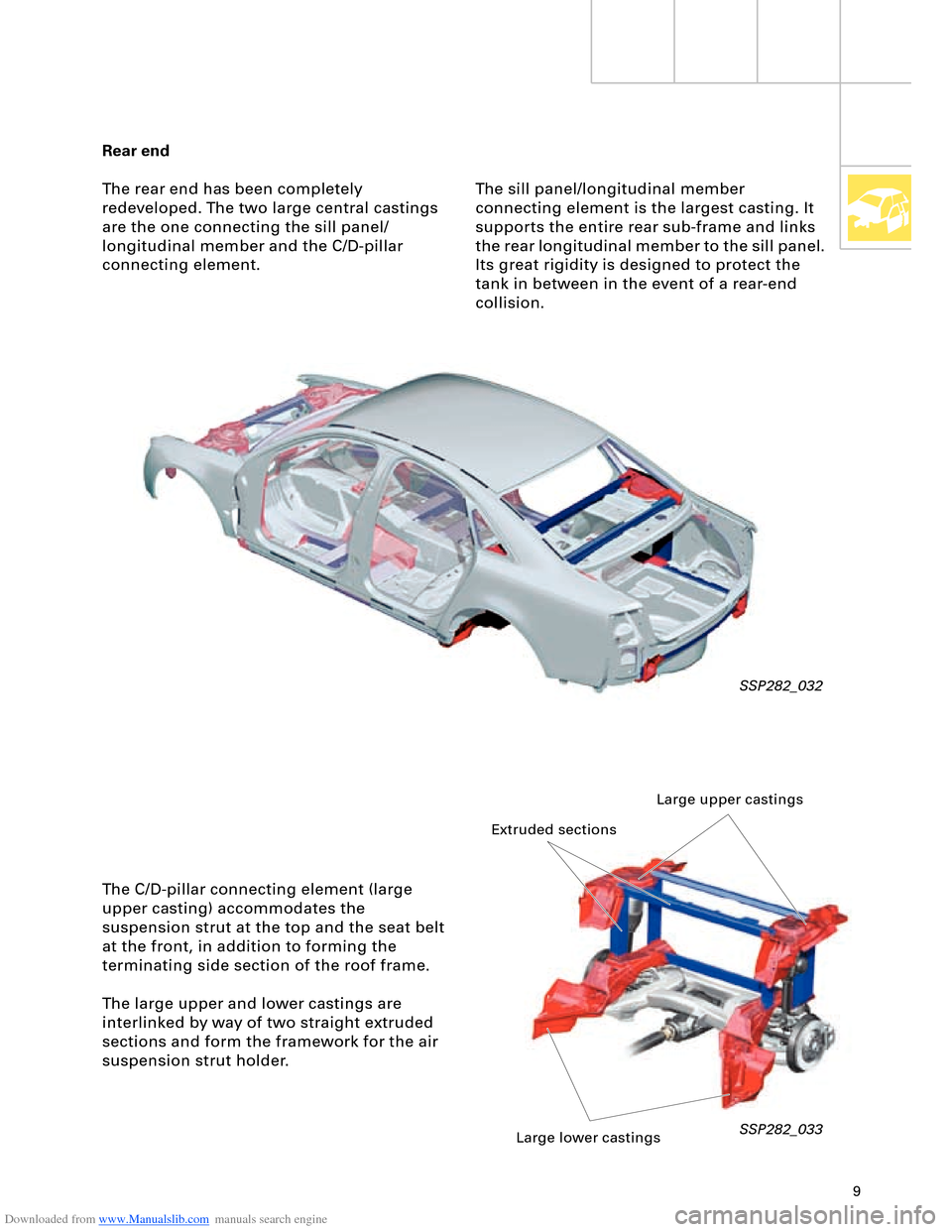
Downloaded from www.Manualslib.com manuals search engine 9
Rear end
The rear end has been completely
redeveloped. The two large central castings
are the one connecting the sill panel/
longitudinal member and the C/D-pillar
connecting element.
SSP282_032
The C/D-pillar connecting element (large
upper casting) accommodates the
suspension strut at the top and the seat belt
at the front, in addition to forming the
terminating side section of the roof frame.
The large upper and lower castings are
interlinked by way of two straight extruded
sections and form the framework for the air
suspension strut holder.
SSP282_033
The sill panel/longitudinal member
connecting element is the largest casting. It
supports the entire rear sub-frame and links
the rear longitudinal member to the sill panel.
Its great rigidity is designed to protect the
tank in between in the event of a rear-end
collision.
Large upper castings
Extruded sections
Large lower castings
Page 13 of 96
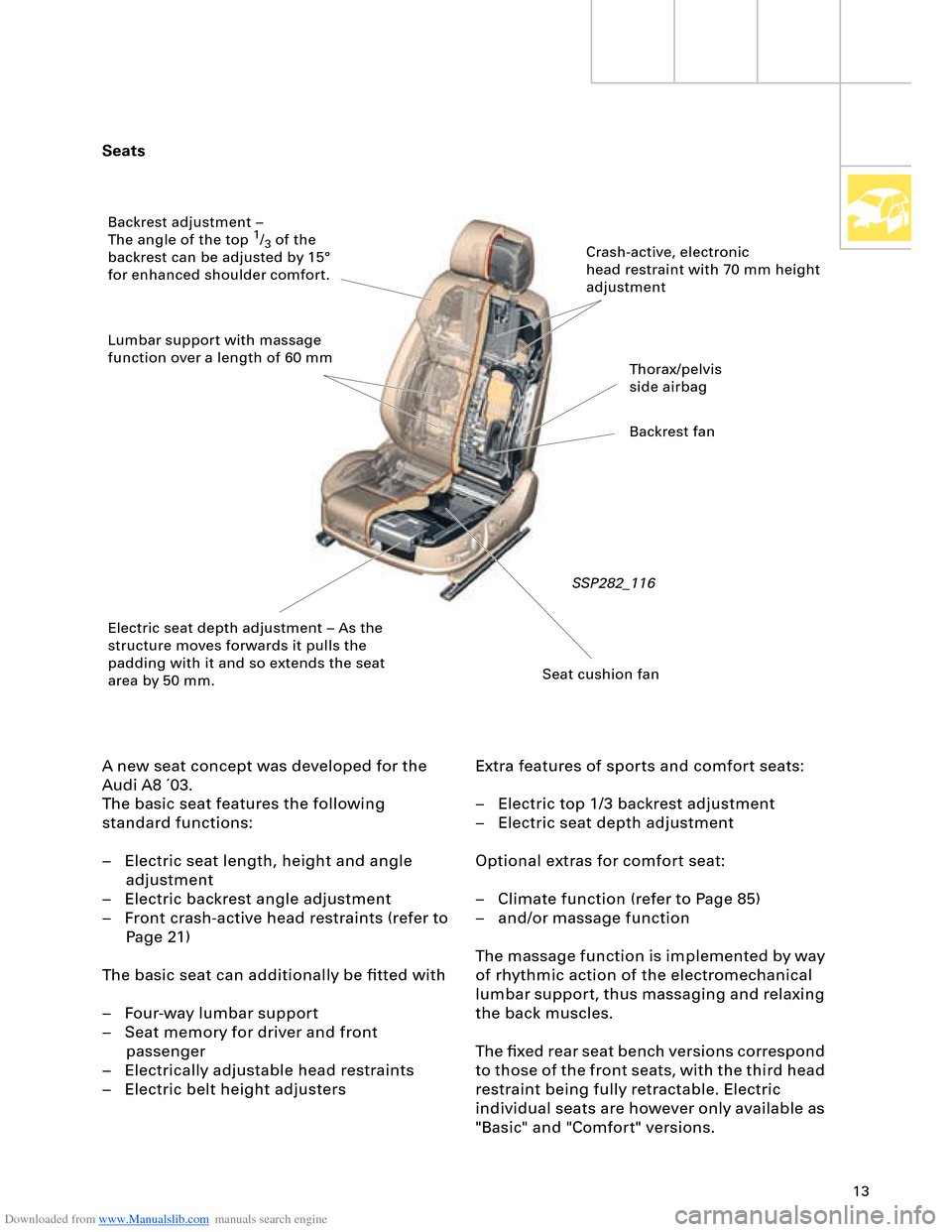
Downloaded from www.Manualslib.com manuals search engine 13
Seats
A new seat concept was developed for the
Audi A8 ´03.
The basic seat features the following
standard functions:
– Electric seat length, height and angle
adjustment
– Electric backrest angle adjustment
– Front crash-active head restraints (refer to
Page 21)
The basic seat can additionally be fitted with
– Four-way lumbar support
– Seat memory for driver and front
passenger
– Electrically adjustable head restraints
– Electric belt height adjustersExtra features of sports and comfort seats:
– Electric top 1/3 backrest adjustment
– Electric seat depth adjustment
Optional extras for comfort seat:
– Climate function (refer to Page 85)
– and/or massage function
The massage function is implemented by way
of rhythmic action of the electromechanical
lumbar support, thus massaging and relaxing
the back muscles.
The fixed rear seat bench versions correspond
to those of the front seats, with the third head
restraint being fully retractable. Electric
individual seats are however only available as
"Basic" and "Comfort" versions.
SSP282_116
Crash-active, electronic
head restraint with 70 mm height
adjustment
Thorax/pelvis
side airbag
Backrest fan
Seat cushion fan Electric seat depth adjustment – As the
structure moves forwards it pulls the
padding with it and so extends the seat
area by 50 mm. Backrest adjustment –
The angle of the top
1/3 of the
backrest can be adjusted by 15°
for enhanced shoulder comfort.
Lumbar support with massage
function over a length of 60 mm
Page 15 of 96
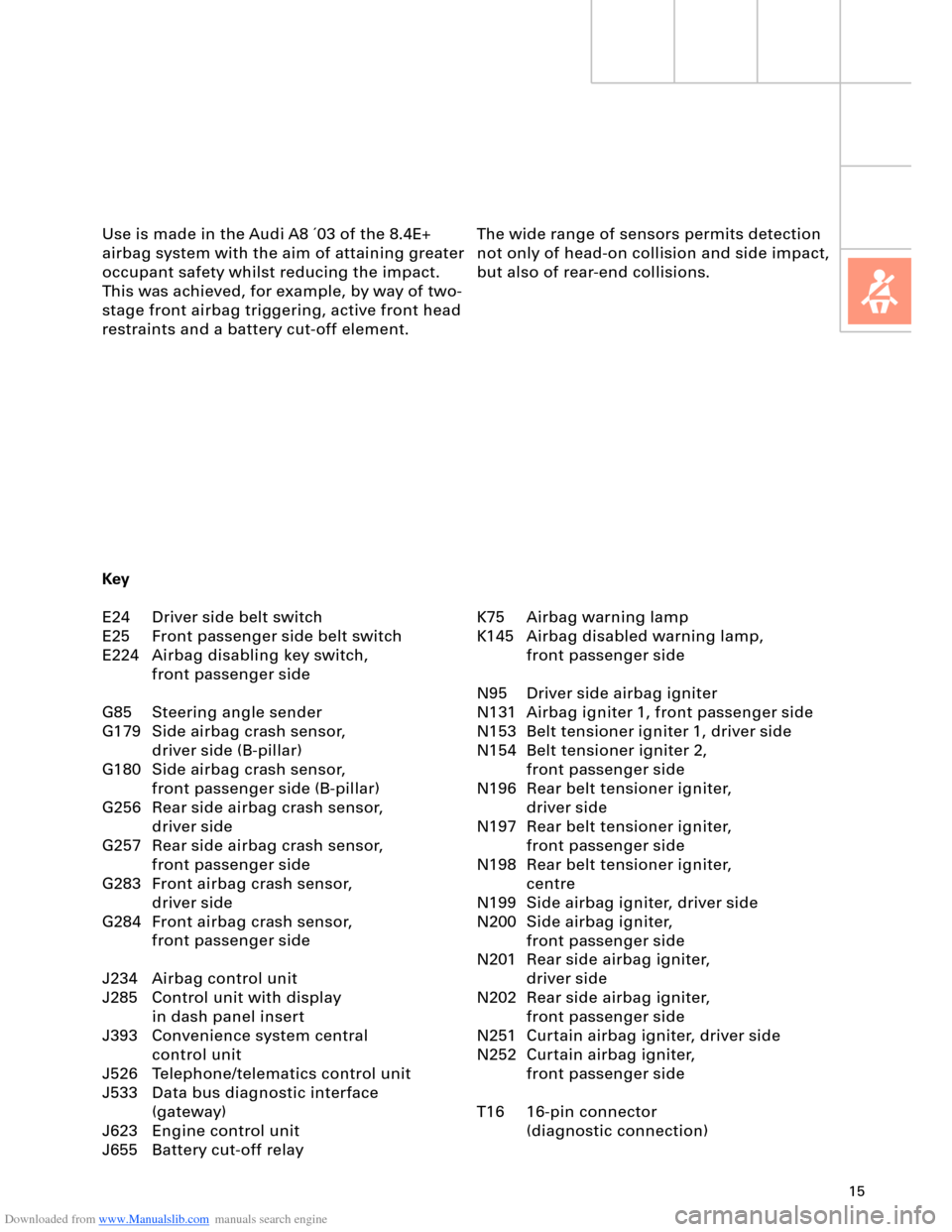
Downloaded from www.Manualslib.com manuals search engine 15
The wide range of sensors permits detection
not only of head-on collision and side impact,
but also of rear-end collisions. Use is made in the Audi A8 ´03 of the 8.4E+
airbag system with the aim of attaining greater
occupant safety whilst reducing the impact.
This was achieved, for example, by way of two-
stage front airbag triggering, active front head
restraints and a battery cut-off element.
K75 Airbag warning lamp
K145 Airbag disabled warning lamp,
front passenger side
N95 Driver side airbag igniter
N131 Airbag igniter 1, front passenger side
N153 Belt tensioner igniter 1, driver side
N154 Belt tensioner igniter 2,
front passenger side
N196 Rear belt tensioner igniter,
driver side
N197 Rear belt tensioner igniter,
front passenger side
N198 Rear belt tensioner igniter,
centre
N199 Side airbag igniter, driver side
N200 Side airbag igniter,
front passenger side
N201 Rear side airbag igniter,
driver side
N202 Rear side airbag igniter,
front passenger side
N251 Curtain airbag igniter, driver side
N252 Curtain airbag igniter,
front passenger side
T16 16-pin connector
(diagnostic connection) Key
E24 Driver side belt switch
E25 Front passenger side belt switch
E224 Airbag disabling key switch,
front passenger side
G85 Steering angle sender
G179 Side airbag crash sensor,
driver side (B-pillar)
G180 Side airbag crash sensor,
front passenger side (B-pillar)
G256 Rear side airbag crash sensor,
driver side
G257 Rear side airbag crash sensor,
front passenger side
G283 Front airbag crash sensor,
driver side
G284 Front airbag crash sensor,
front passenger side
J234 Airbag control unit
J285 Control unit with display
in dash panel insert
J393 Convenience system central
control unit
J526 Telephone/telematics control unit
J533 Data bus diagnostic interface
(gateway)
J623 Engine control unit
J655 Battery cut-off relay
Page 16 of 96
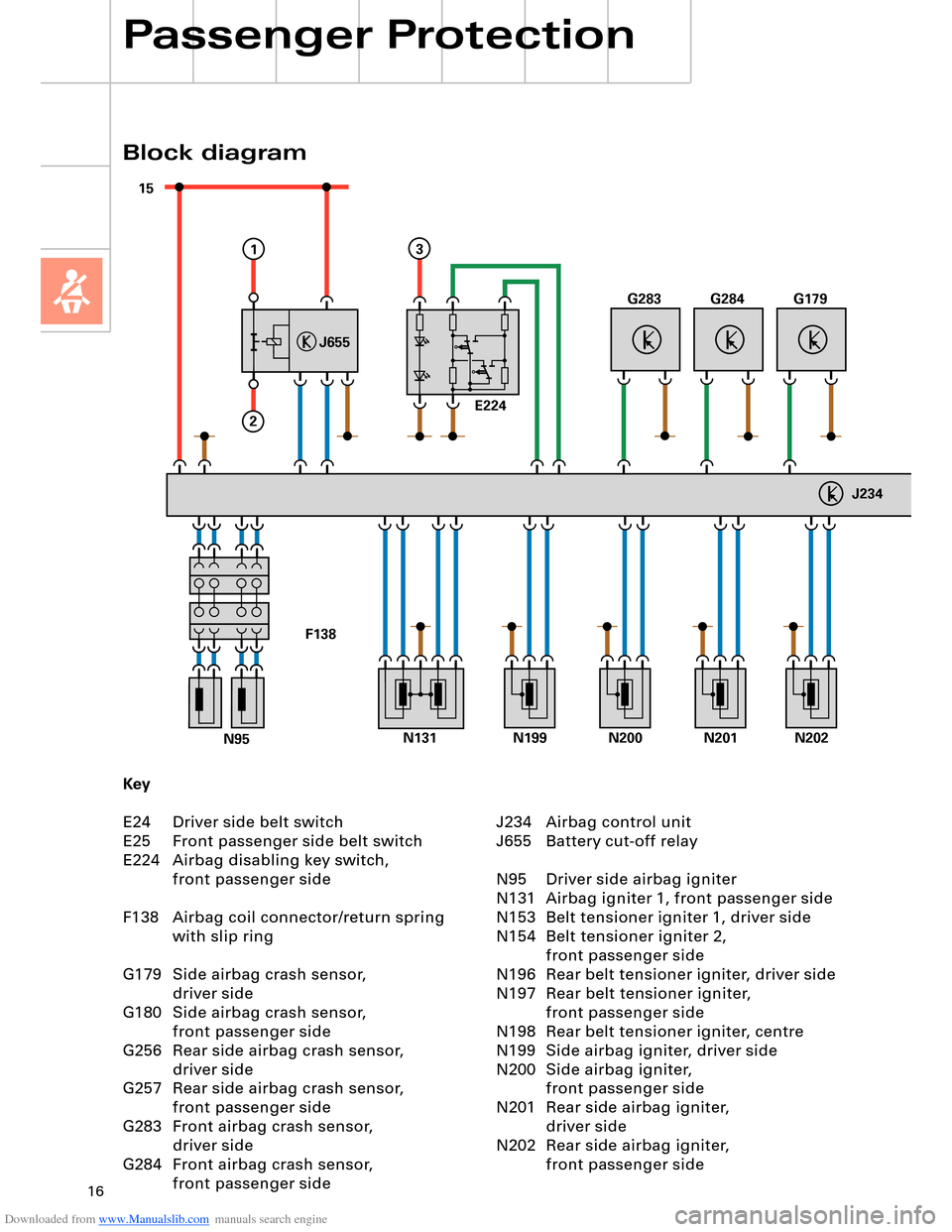
Downloaded from www.Manualslib.com manuals search engine 16
15
J234
J655
1
2
E224
3
G283G284G179
N131
F138
N202N199N200N201N95
Key
E24 Driver side belt switch
E25 Front passenger side belt switch
E224 Airbag disabling key switch,
front passenger side
F138 Airbag coil connector/return spring
with slip ring
G179 Side airbag crash sensor,
driver side
G180 Side airbag crash sensor,
front passenger side
G256 Rear side airbag crash sensor,
driver side
G257 Rear side airbag crash sensor,
front passenger side
G283 Front airbag crash sensor,
driver side
G284 Front airbag crash sensor,
front passenger side
Block diagram
Passenger Protection
J234 Airbag control unit
J655 Battery cut-off relay
N95 Driver side airbag igniter
N131 Airbag igniter 1, front passenger side
N153 Belt tensioner igniter 1, driver side
N154 Belt tensioner igniter 2,
front passenger side
N196 Rear belt tensioner igniter, driver side
N197 Rear belt tensioner igniter,
front passenger side
N198 Rear belt tensioner igniter, centre
N199 Side airbag igniter, driver side
N200 Side airbag igniter,
front passenger side
N201 Rear side airbag igniter,
driver side
N202 Rear side airbag igniter,
front passenger side
Page 18 of 96
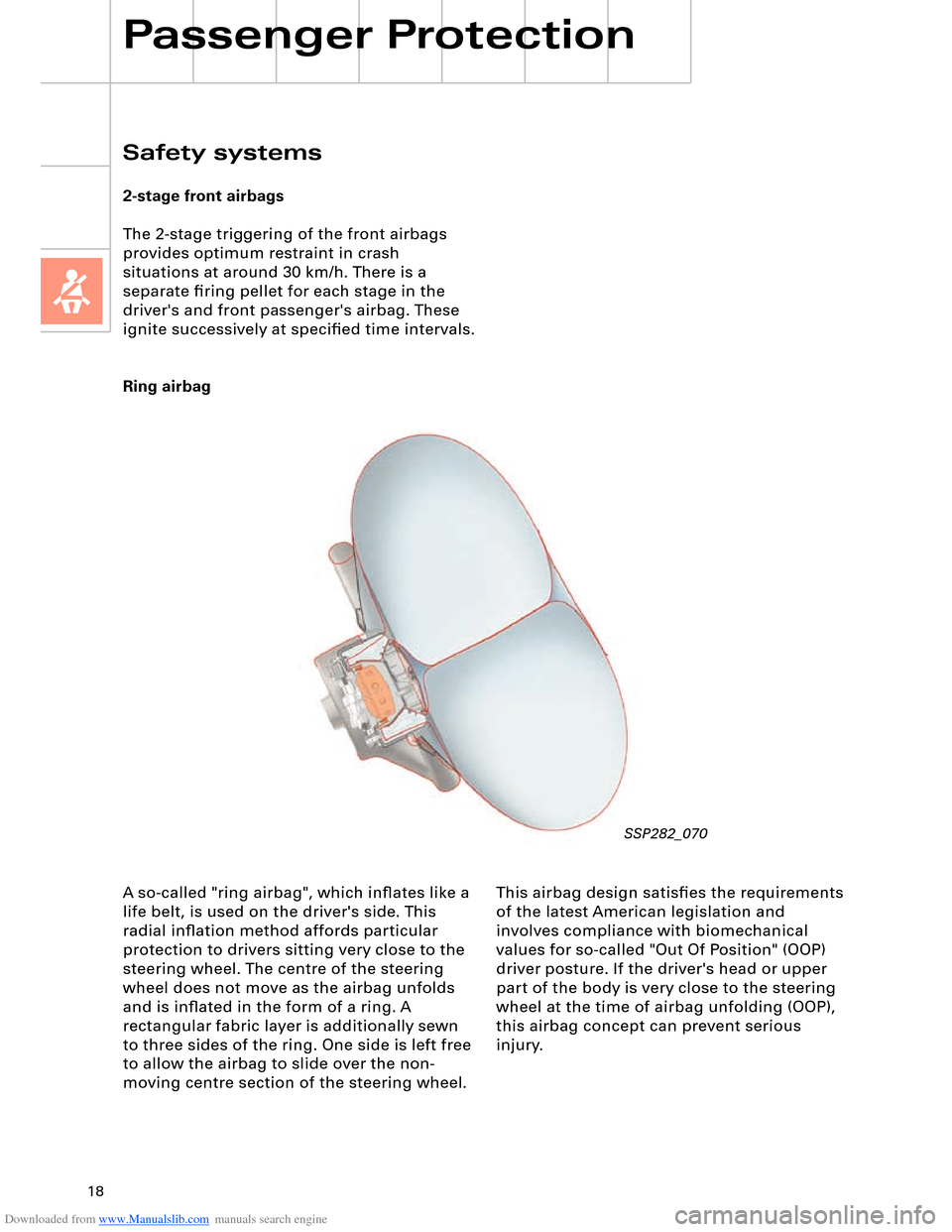
Downloaded from www.Manualslib.com manuals search engine 18
Safety systems
2-stage front airbags
The 2-stage triggering of the front airbags
provides optimum restraint in crash
situations at around 30 km/h. There is a
separate firing pellet for each stage in the
driver's and front passenger's airbag. These
ignite successively at specified time intervals.
Ring airbag
Passenger Protection
SSP282_070
A so-called "ring airbag", which inflates like a
life belt, is used on the driver's side. This
radial inflation method affords particular
protection to drivers sitting very close to the
steering wheel. The centre of the steering
wheel does not move as the airbag unfolds
and is inflated in the form of a ring. A
rectangular fabric layer is additionally sewn
to three sides of the ring. One side is left free
to allow the airbag to slide over the non-
moving centre section of the steering wheel. This airbag design satisfies the requirements
of the latest American legislation and
involves compliance with biomechanical
values for so-called "Out Of Position" (OOP)
driver posture. If the driver's head or upper
part of the body is very close to the steering
wheel at the time of airbag unfolding (OOP),
this airbag concept can prevent serious
injury.
Page 21 of 96
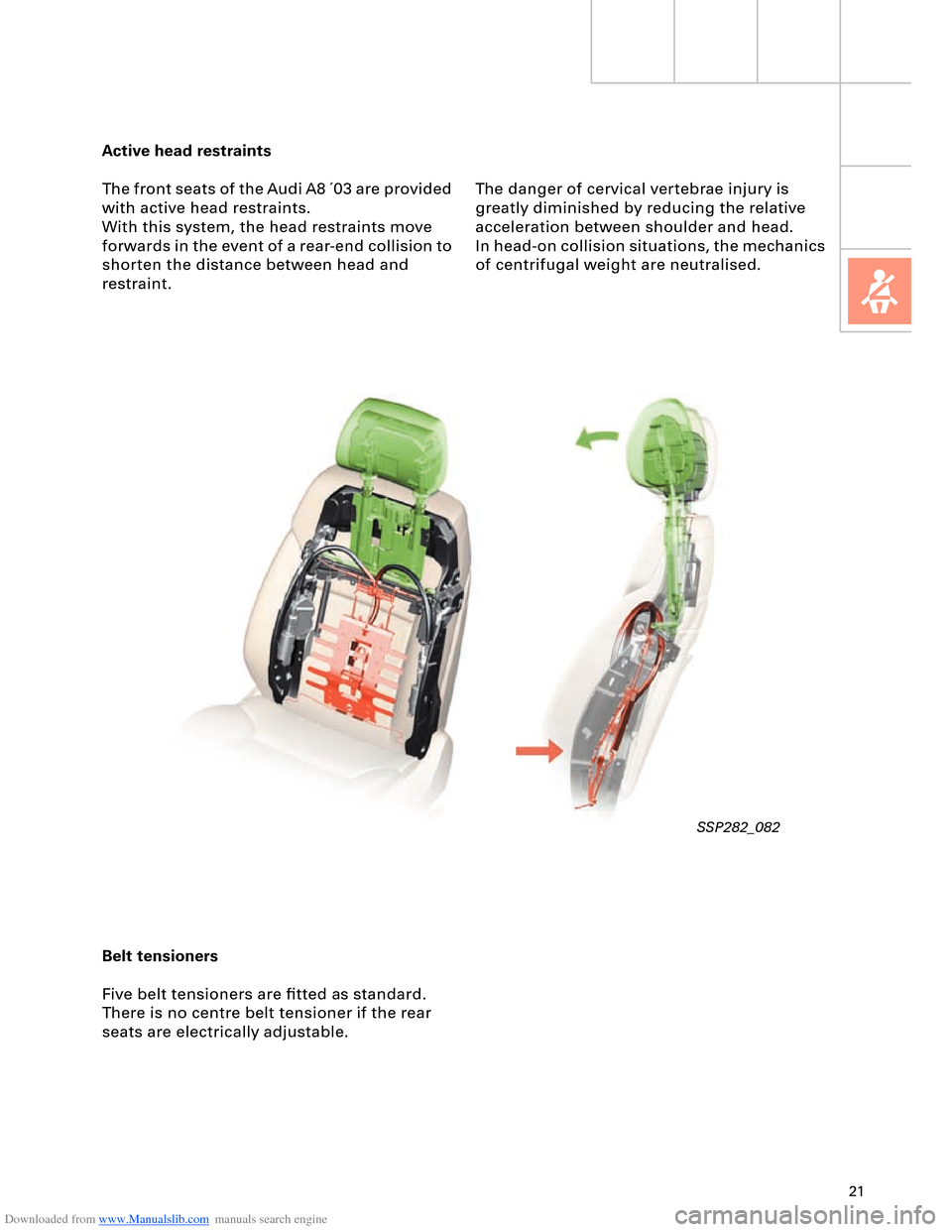
Downloaded from www.Manualslib.com manuals search engine 21
Active head restraints
The front seats of the Audi A8 ´03 are provided
with active head restraints.
With this system, the head restraints move
forwards in the event of a rear-end collision to
shorten the distance between head and
restraint.
SSP282_082
The danger of cervical vertebrae injury is
greatly diminished by reducing the relative
acceleration between shoulder and head.
In head-on collision situations, the mechanics
of centrifugal weight are neutralised.
Belt tensioners
Five belt tensioners are fitted as standard.
There is no centre belt tensioner if the rear
seats are electrically adjustable.
Page 53 of 96
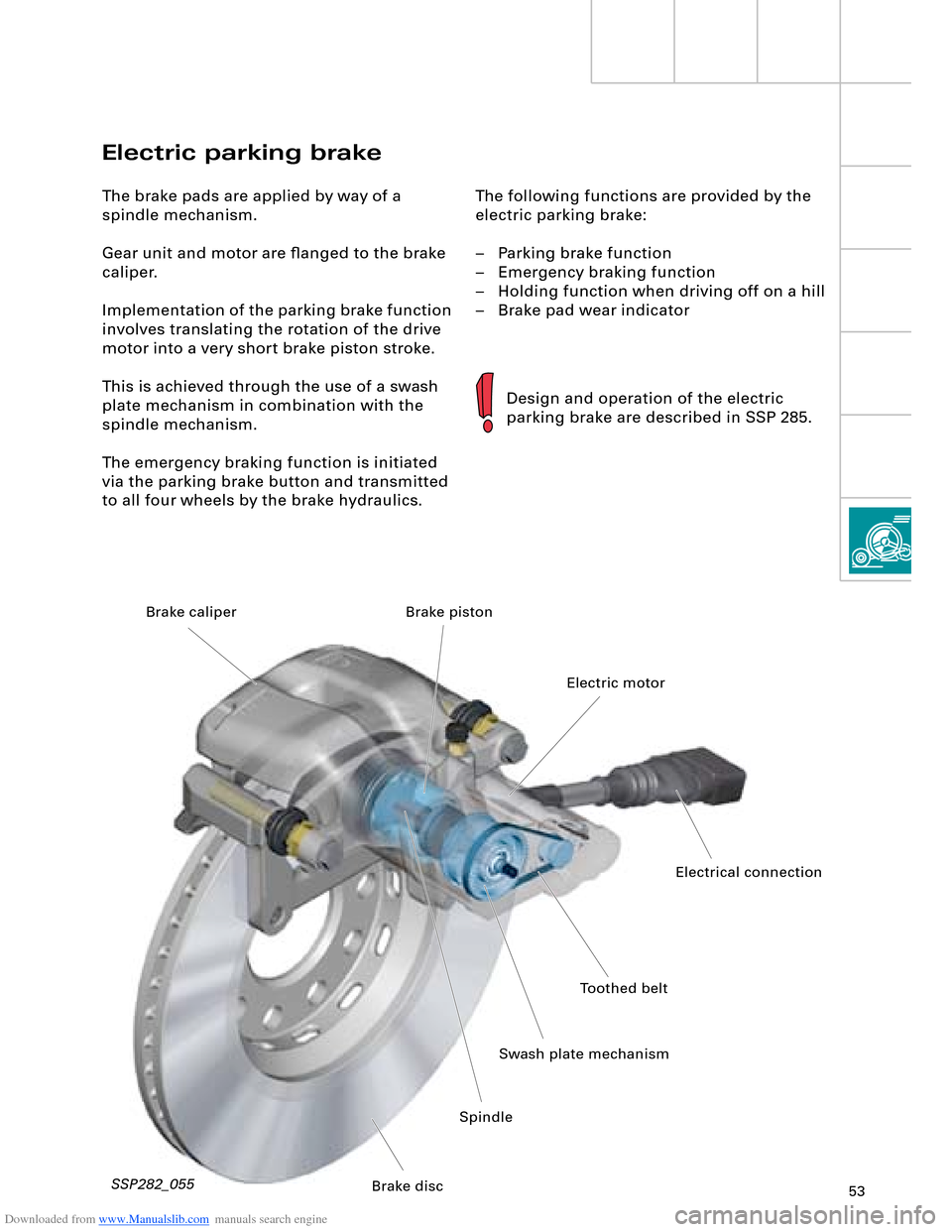
Downloaded from www.Manualslib.com manuals search engine 53
The following functions are provided by the
electric parking brake:
– Parking brake function
– Emergency braking function
– Holding function when driving off on a hill
– Brake pad wear indicator
Electric parking brake
The brake pads are applied by way of a
spindle mechanism.
Gear unit and motor are flanged to the brake
caliper.
Implementation of the parking brake function
involves translating the rotation of the drive
motor into a very short brake piston stroke.
This is achieved through the use of a swash
plate mechanism in combination with the
spindle mechanism.
The emergency braking function is initiated
via the parking brake button and transmitted
to all four wheels by the brake hydraulics.
Design and operation of the electric
parking brake are described in SSP 285.
SSP282_055
Toothed belt
Swash plate mechanismElectric motor Brake piston
SpindleElectrical connection
Brake disc Brake caliper